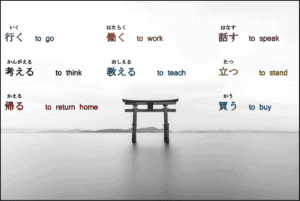Creating Japanese invitations, proposals, and offers is an integral part of Japanese culture. It’s not just about language, but also about understanding the nuances of Japanese invitation customs. In this article, we delve into the Volitional Form of Japanese, a grammar form that expresses a willingness or desire to do something, often used in crafting a Japanese invitation.
Before you embark on this lesson, we recommend checking out our other lessons on how to use Japanese verbs, which will provide a solid foundation for writing Japanese invitations.
What is the volitional form in Japanese?
The most straightforward translation of the volitional form in Japanese is “Let’s…”. It is used when proposing to do something together, a common practice in traditional Japanese invitations. For instance:
映画を見ましょう。 “Let’s watch a movie.”
休憩しよう。 “Let’s take a break.”
However, the volitional form in Japanese can mean different things when used in various contexts. For example, when crafting a Japanese invitation:
休憩しようか。 “Why don’t you take a break?”
座りましょうか。 “Won’t you sit down?”
It can also be used to offer to do something for someone, a common practice in formal invitations in Japanese:
手伝いましょうか。 “Shall I help you?”
持ちましょうか。 “Shall I carry it?”
教えましょうか。 “Shall I tell you/him/her?”
As you can see, the volitional form in Japanese is very context-dependent. But don’t worry! This is only a problem when trying to translate it into English – it is actually very simple and easy to understand once you get used to it!
How to use the volitional form in Japanese Invitations
To craft Japanese invitations and offers, all you need to do is to change the “stem” of the verb. The stem is the ―ます ”-masu” part of a present tense verb. We will look at the two main ways to do this: the polite form and the casual form.
First, let’s learn how to make invitations and offers in Japanese politely, a key aspect of Japanese invitation etiquette.
.
How to Create Polite Japanese Invitations

Making a Japanese verb into the polite volitional form is very simple. Simply, you should change “-masu” to “-mashou.”
行きます。。。。。行きましょう
ikimasu………………ikimashou
“go”…………………..“Let’s go”
書きます。。。。。書きましょう
kakimasu……………kakimashou
“write”………………”let’s write”
食べます。。。。。食べましょう
tabemasu………tabemashou
“eat” “let’s eat”
します。。。。。。しましょう
shimasu…….shimashou
“do” “let’s do”
持って来ます。。。。。。持って来ましょう
mottekimasu……………….mottekimashou
“bring <something>” “let’s bring <something>”
Now, using these 5 Japanese verbs, let’s look at some examples.
サッカーしましょう。 Let’s play soccer.
sakkaa shimashou
本を持って来ましょう。 Let’s bring a book.
hon wo mottekimashou.
ここで名前を書きましょう。 Write your name here.
koko de namae wo kakimashou.
寿司をたべましょうか。 Shall we eat sushi?
sushi wo tabemashou.
These are some examples of Japanese invitation phrases. Can you translate these examples to English?
- 一緒いっしょに日本語を勉強べんきょうしましょう!
Isshoni nihongo wo benkyoushimashou!
- 協力しましょう
Kyouryokushimashou
- おすしを食たべましょうか?
Osushi wo tabemashouka?
- 私が運転しましょうか?
Watashi ga untenshimashouka?
- 名前を書きましょう。
namae wo kakimashou.
When you are ready, check your answers below.
Answers:
- 一緒いっしょに日本語を勉強べんきょうしましょう!
“Let’s study Japanese together”
- 協力しましょう
“Let’s work together”
- おすしを食たべましょうか?
“Shall we eat sushi?”
- 私が運転しましょうか?
“Shall I drive?”
- 名前を書きましょう。
“Let’s write our names.”
Do you want to work in Japan? Check out our guides here!
How to Create Casual Japanese Invitations
You also change the stem of a verb to use the volitional form in a casual way. This is very similar to the polite form, but the casual form changes depending on the “type” of verb.
Essentially, there are 3 verb types. U-verbs, Ru-verbs, and group 3 verbs.
The volitional form of group 1 “u” verbs
To make offers and invitations in Japanese with group 1 verbs, simply change “u” to “ou.”
行く。。。。行こう
iku………ikou
Go Let’s go
読む。。。。読もう
yomu………..yomou
Read Let’s read
続く。。。。続こう
tsuzsuku……..tsuzsukou
Continue Let’s continue
遊ぶ。。。。遊ぼう
asobu…………asobou
Play Let’s play
話す。。。。話そう
hanasu…………hanasou
Speak Let’s speak
Now, using these Japanese verbs, let’s look at some examples of casual Japanese invitation phrases.
公園で遊ぼう。 Let’s play at the park.
kouen de asobou.
東京に行こう。 Let’s go to Tokyo.
toukyou ni ikou
メニューを読もう。 Let’s read the menu.
menyuu wo yomou.
レストランに行こうか。 Shall we go to a restaurant?
resutoran ni ikouka.
Can you translate these examples into English?
- 富士山へ行こう!
Fujisan he ikou!
- 国へ帰かえって、日本語の勉強を続こう。
Kuni he kaette, nihongo no benkyou wo tsuzsukou.
- 本当の事ことを話そう。
Hontou no koto wo hanasou.
- この本を読もう。
kono hon wo yomou.
- レストランで話そうか。
resutoran de hanasouka.
When you are ready, check your answers below.
Answers:
- 富士山へ行こう!
“Let’s go to Mt. Fuji!”
- 国へ帰かえって、日本語の勉強を続こう。
“After I return to my country, let’s continue to study Japanese.”
- 本当の事ことを話そう。
“Let’s speak the truth.”
- この本を読もう。
“Let’s read this book.”
- レストランで話そうか。
“Why don’t we speak at the restaurant?”
The volitional form of group 2 “ru” verbs
To make offers and invitations in Japanese with group 2 “ru” verbs, just change “ru” to “you.”
Let’s look at some examples:
食べる。。。。食べよう
taberu…………..tabeyou
eat
考える。。。。考えよう
kangaeru……….kangaeyou
consider
あげる。。。。あげよう
ageru……………ageyou
give
着替える。。。着替えよう
kigaeru…………kigaeyou
“change clothes”
Now, using these Japanese verbs, let’s look at some examples.
服を着替えよう。 Let’s get changed.
よく考えよう。 Let’s think about this.
彼女にお土産をあげよう。 Let’s give her a souvenir.
Can you translate these examples into English?
- 着物に着替えよう。
Kimono ni kikaeyou.
“Let’s get changed into Kimonos.”
- 地図を書いてあげよう。
Chizu wo kaite ageyou.
“Let me draw you a map.”
- 大学に入る事、考えよう。
Daigaku ni hairu koto, kangaeyou.
I shall think about entering University.”
- 今何を食べようか。
ima nani wo tabeyouka.
When you are ready, check your answers below.
Answers:
- 着物に着替えよう。
“Let’s get changed into Kimonos.”
- 地図を書いてあげよう。
“Let me draw you a map.”
- 大学に入る事、考えよう。
“I shall think about entering University.”
- 今何を食べようか。
What shall we eat now?
The volitional form of group 3 verbs
Essentially, group 3 consist of only 2 verbs – “suru” (to do) and “kuru” (to come). Simply remember that “suru” becomes “shiyou,” and “kuru” become “koyou”
勉強しょう。
Benkyoushiyou.
“let’s study.”
How different is English from Japanese? Find out here!
The volitional form in Japanese: Translate these sentences
Now it’s time for something a little more difficult! Can you translate the following sentences?
- 日本へ旅行しよう。
Nihon he ryokoushiyou.
- 毎日運動しょう、ね?
Mainichi undoushiyou, ne?
- 冬から英語を習い始めようと思おもいます。
Fuyu kara eigo wo narai hajimeyou to omoimasu.
- 来月、仕事を辞めようと思っている。
Raigetsu, shigoto wo yameyou to omotteiru.
- 今朝、友達に会おうとしましたが、会う事ができませんでした。
Kesa, tomodachi ni aou to shimashita ga, au koto ga demimasen deshita.
When you are ready, check your answers below.
Answers:
- 日本へ旅行しよう。
Let’s travel Japan.
- 毎日運動しょう、ね?
Exercise every day, alright?
- 冬から英語を習い始めようと思おもいます。
I think I will start studying English from this winter.
- 来月、仕事を辞めようと思っている。
Next month, I’m thinking of quitting my job.
- 今朝、友達に会おうとしましたが、会う事ができませんでした。
This morning, I tried to meet my friend, but I wasn’t able to meet them.
A different way to make invitations in Japanese
There is a second way of making invitations in Japanese, and this is also extremely common.
Take a look at the examples below. What do you think they mean?
- 何か食べませんか。
2. どこか行きませんか。
3. 座りませんか。
4. 私に少し時間をいただけませんか?
5. 映画を見に行きませんか。
When you’re ready, check your answers below:
- 何か食べませんか。
Why don’t we eat something? / Won’t you have something to eat?
2. どこか行きませんか。
Shall we go somewhere? / Why don’t we go somewhere?
3. 座りませんか。
Won’t you sit down?
4. 私に少し時間をいただけませんか?
Could you give me a little time? / Won’t you give me a little time?
5. 一緒に映画を見に行きませんか。
Why don’t we go see a movie?
By simply transforming the stem of the verb to the negative, and adding –ka, you form an invitation.
These are just a few examples of how you can use the volitional form in creating a Japanese invitation. By understanding and practicing these forms, you can effectively communicate your intentions in a way that is respectful and understanding of Japanese culture and etiquette. Whether you’re writing a formal invitation in Japanese or just want to invite a friend to a casual event, these phrases, and forms will be invaluable.
We hope this guide has been helpful in understanding the intricacies of crafting Japanese invitations. For more examples and practice, be sure to check out our other lessons on Japanese language and culture. Happy learning!
Hopefully, you now have a better grasp of how to use verbs in Japanese. Check out more lessons on our website!
And if you still need some help, check out our article about helpful travel apps!



